Impact of COVID-19 Pandemic on Business and Strategic Responses
VerifiedAdded on 2022/07/29
|10
|2738
|51
Report
AI Summary
This report analyzes the multifaceted impact of the COVID-19 pandemic on various aspects of business and economics. It begins by assessing the widespread disruptions caused by the virus, including its impact on global economies, travel, and trade, particularly in the ASEAN+3 region. The report then explores strategic responses to these challenges, such as the adoption of decentralized production facilities and the critical management of global supply chains. It provides insights into how companies can mitigate risks and maintain operational efficiency, including an examination of IT sector revenue declines and the importance of supply chain agility. Furthermore, the report delves into corporate social responsibility (CSR) approaches, differentiating between traditional philanthropic activities and strategic CSR, especially within the healthcare industry. It recommends a strategic approach that aligns business resources to create both financial and non-financial value, ensuring long-term sustainability and positive societal impact. The report concludes by offering practical advice for businesses navigating the complexities of a pandemic environment, emphasizing the importance of proactive planning and adaptation.
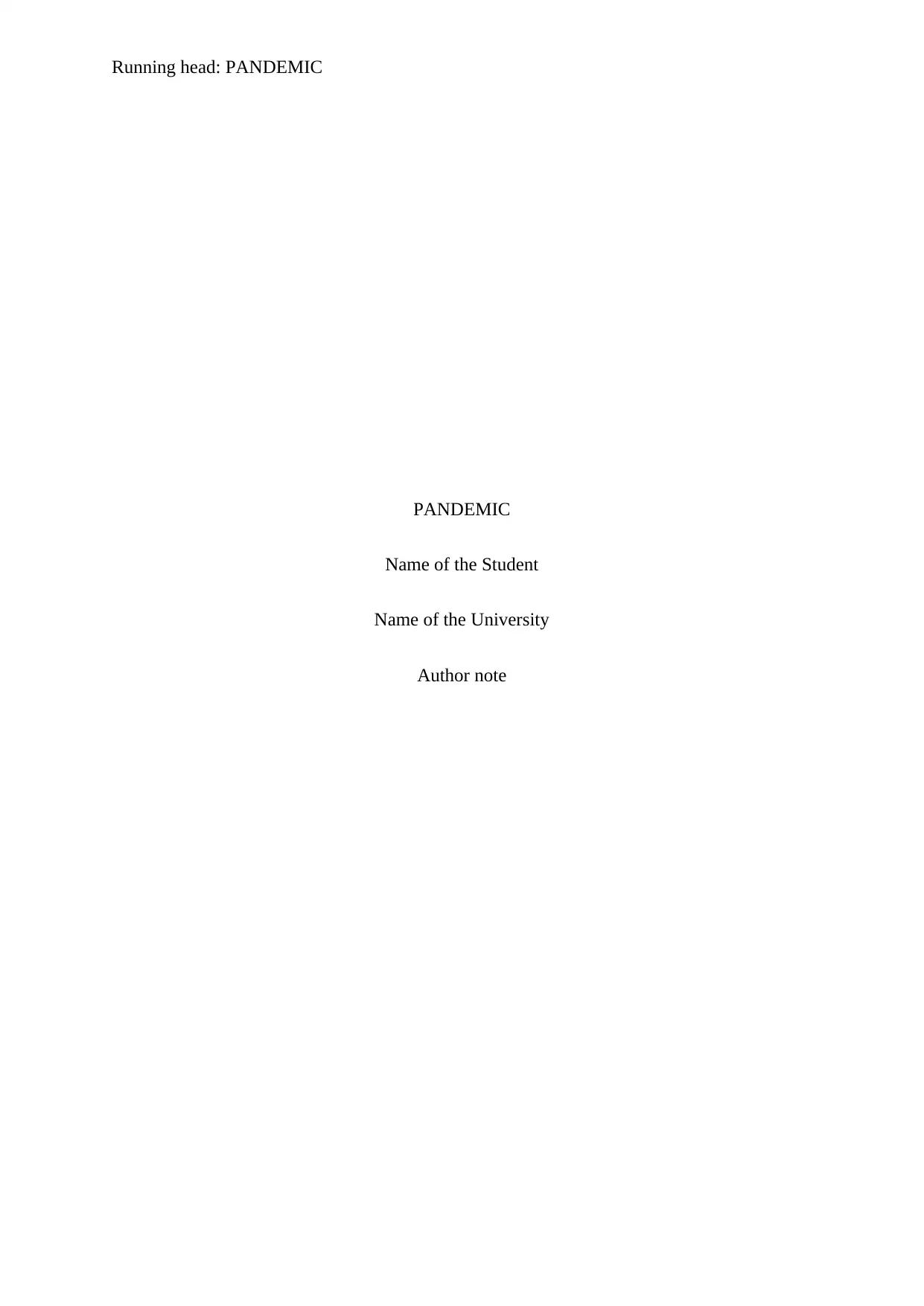
Running head: PANDEMIC
PANDEMIC
Name of the Student
Name of the University
Author note
PANDEMIC
Name of the Student
Name of the University
Author note
Paraphrase This Document
Need a fresh take? Get an instant paraphrase of this document with our AI Paraphraser
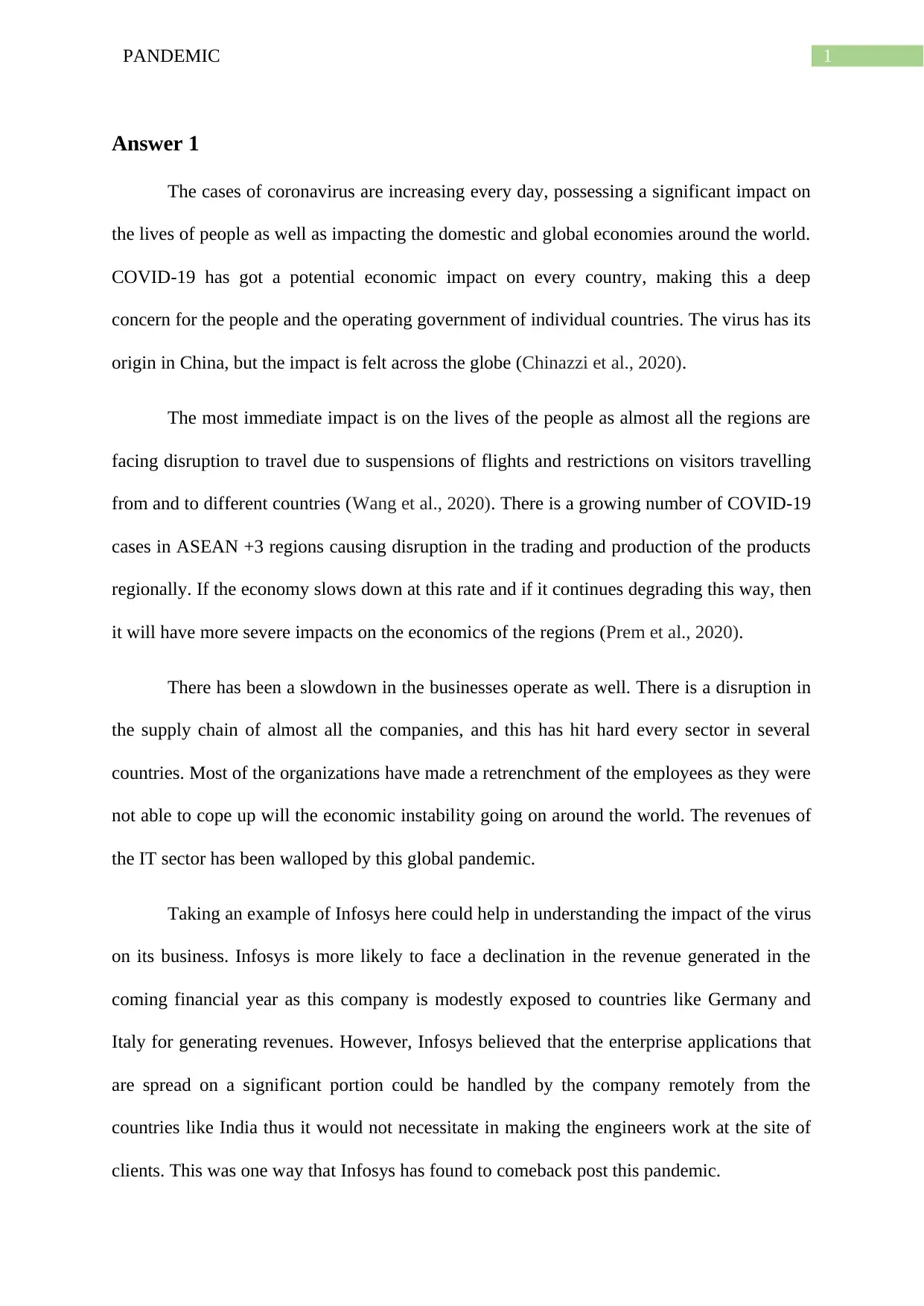
1PANDEMIC
Answer 1
The cases of coronavirus are increasing every day, possessing a significant impact on
the lives of people as well as impacting the domestic and global economies around the world.
COVID-19 has got a potential economic impact on every country, making this a deep
concern for the people and the operating government of individual countries. The virus has its
origin in China, but the impact is felt across the globe (Chinazzi et al., 2020).
The most immediate impact is on the lives of the people as almost all the regions are
facing disruption to travel due to suspensions of flights and restrictions on visitors travelling
from and to different countries (Wang et al., 2020). There is a growing number of COVID-19
cases in ASEAN +3 regions causing disruption in the trading and production of the products
regionally. If the economy slows down at this rate and if it continues degrading this way, then
it will have more severe impacts on the economics of the regions (Prem et al., 2020).
There has been a slowdown in the businesses operate as well. There is a disruption in
the supply chain of almost all the companies, and this has hit hard every sector in several
countries. Most of the organizations have made a retrenchment of the employees as they were
not able to cope up will the economic instability going on around the world. The revenues of
the IT sector has been walloped by this global pandemic.
Taking an example of Infosys here could help in understanding the impact of the virus
on its business. Infosys is more likely to face a declination in the revenue generated in the
coming financial year as this company is modestly exposed to countries like Germany and
Italy for generating revenues. However, Infosys believed that the enterprise applications that
are spread on a significant portion could be handled by the company remotely from the
countries like India thus it would not necessitate in making the engineers work at the site of
clients. This was one way that Infosys has found to comeback post this pandemic.
Answer 1
The cases of coronavirus are increasing every day, possessing a significant impact on
the lives of people as well as impacting the domestic and global economies around the world.
COVID-19 has got a potential economic impact on every country, making this a deep
concern for the people and the operating government of individual countries. The virus has its
origin in China, but the impact is felt across the globe (Chinazzi et al., 2020).
The most immediate impact is on the lives of the people as almost all the regions are
facing disruption to travel due to suspensions of flights and restrictions on visitors travelling
from and to different countries (Wang et al., 2020). There is a growing number of COVID-19
cases in ASEAN +3 regions causing disruption in the trading and production of the products
regionally. If the economy slows down at this rate and if it continues degrading this way, then
it will have more severe impacts on the economics of the regions (Prem et al., 2020).
There has been a slowdown in the businesses operate as well. There is a disruption in
the supply chain of almost all the companies, and this has hit hard every sector in several
countries. Most of the organizations have made a retrenchment of the employees as they were
not able to cope up will the economic instability going on around the world. The revenues of
the IT sector has been walloped by this global pandemic.
Taking an example of Infosys here could help in understanding the impact of the virus
on its business. Infosys is more likely to face a declination in the revenue generated in the
coming financial year as this company is modestly exposed to countries like Germany and
Italy for generating revenues. However, Infosys believed that the enterprise applications that
are spread on a significant portion could be handled by the company remotely from the
countries like India thus it would not necessitate in making the engineers work at the site of
clients. This was one way that Infosys has found to comeback post this pandemic.
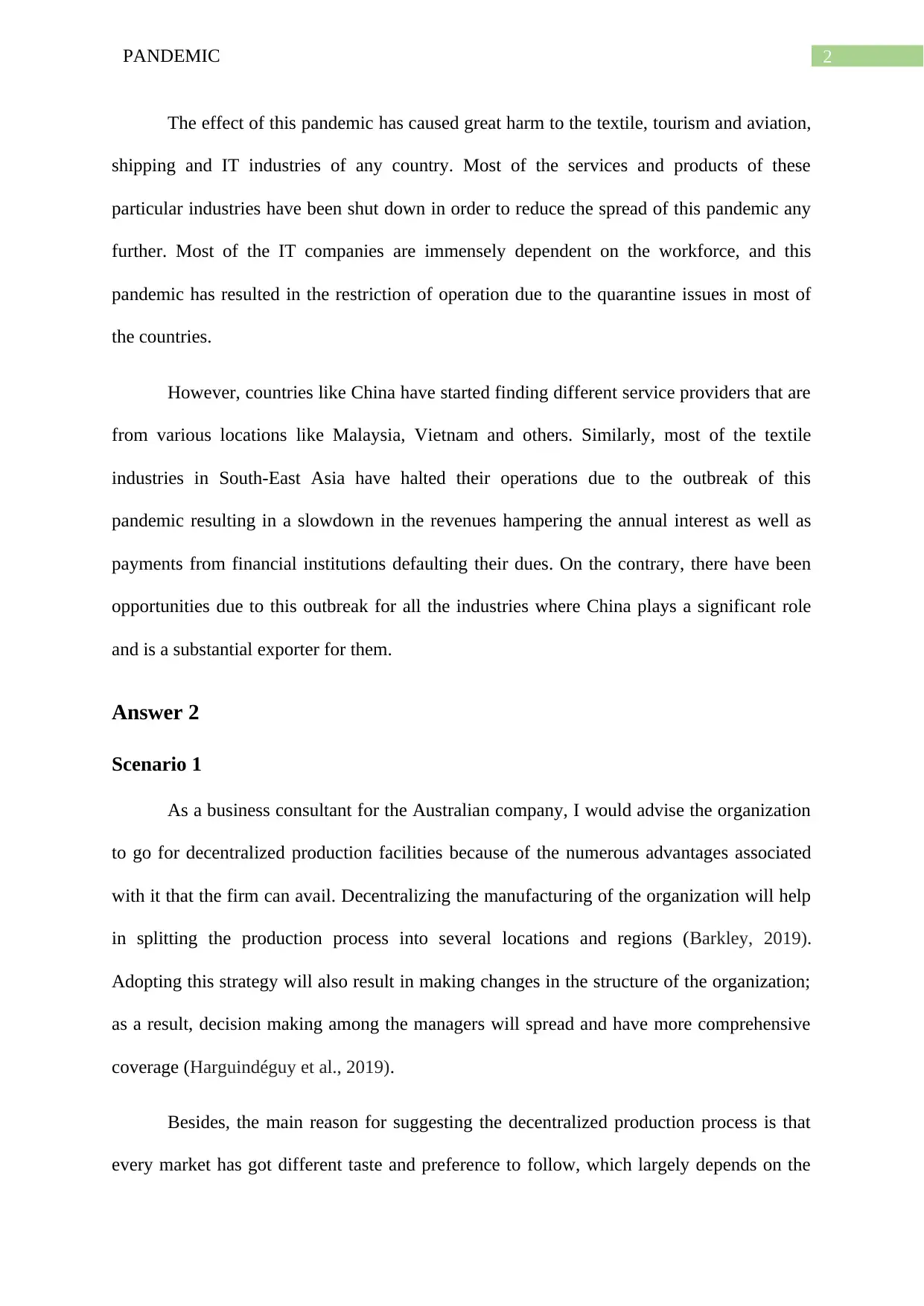
2PANDEMIC
The effect of this pandemic has caused great harm to the textile, tourism and aviation,
shipping and IT industries of any country. Most of the services and products of these
particular industries have been shut down in order to reduce the spread of this pandemic any
further. Most of the IT companies are immensely dependent on the workforce, and this
pandemic has resulted in the restriction of operation due to the quarantine issues in most of
the countries.
However, countries like China have started finding different service providers that are
from various locations like Malaysia, Vietnam and others. Similarly, most of the textile
industries in South-East Asia have halted their operations due to the outbreak of this
pandemic resulting in a slowdown in the revenues hampering the annual interest as well as
payments from financial institutions defaulting their dues. On the contrary, there have been
opportunities due to this outbreak for all the industries where China plays a significant role
and is a substantial exporter for them.
Answer 2
Scenario 1
As a business consultant for the Australian company, I would advise the organization
to go for decentralized production facilities because of the numerous advantages associated
with it that the firm can avail. Decentralizing the manufacturing of the organization will help
in splitting the production process into several locations and regions (Barkley, 2019).
Adopting this strategy will also result in making changes in the structure of the organization;
as a result, decision making among the managers will spread and have more comprehensive
coverage (Harguindéguy et al., 2019).
Besides, the main reason for suggesting the decentralized production process is that
every market has got different taste and preference to follow, which largely depends on the
The effect of this pandemic has caused great harm to the textile, tourism and aviation,
shipping and IT industries of any country. Most of the services and products of these
particular industries have been shut down in order to reduce the spread of this pandemic any
further. Most of the IT companies are immensely dependent on the workforce, and this
pandemic has resulted in the restriction of operation due to the quarantine issues in most of
the countries.
However, countries like China have started finding different service providers that are
from various locations like Malaysia, Vietnam and others. Similarly, most of the textile
industries in South-East Asia have halted their operations due to the outbreak of this
pandemic resulting in a slowdown in the revenues hampering the annual interest as well as
payments from financial institutions defaulting their dues. On the contrary, there have been
opportunities due to this outbreak for all the industries where China plays a significant role
and is a substantial exporter for them.
Answer 2
Scenario 1
As a business consultant for the Australian company, I would advise the organization
to go for decentralized production facilities because of the numerous advantages associated
with it that the firm can avail. Decentralizing the manufacturing of the organization will help
in splitting the production process into several locations and regions (Barkley, 2019).
Adopting this strategy will also result in making changes in the structure of the organization;
as a result, decision making among the managers will spread and have more comprehensive
coverage (Harguindéguy et al., 2019).
Besides, the main reason for suggesting the decentralized production process is that
every market has got different taste and preference to follow, which largely depends on the
⊘ This is a preview!⊘
Do you want full access?
Subscribe today to unlock all pages.

Trusted by 1+ million students worldwide
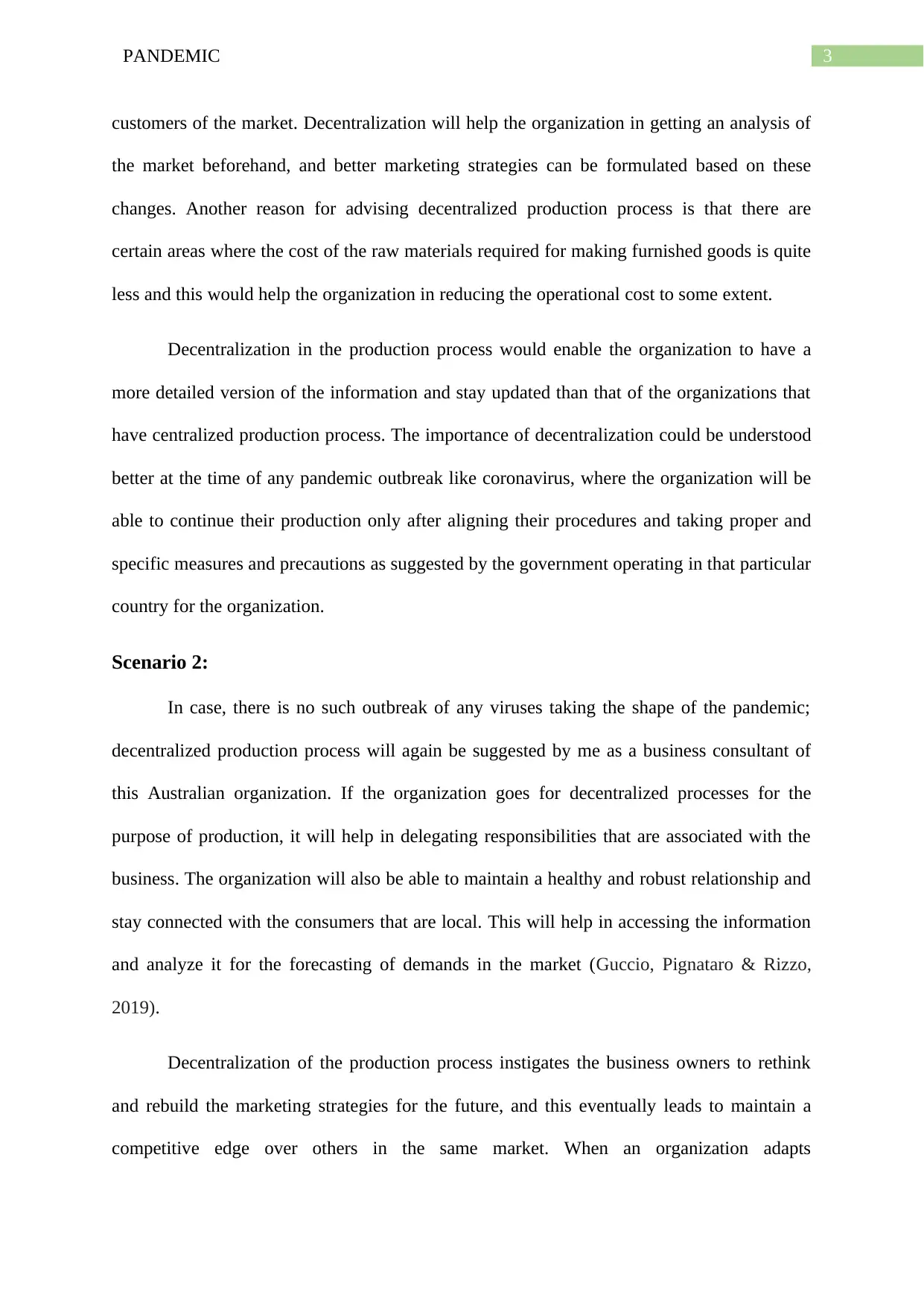
3PANDEMIC
customers of the market. Decentralization will help the organization in getting an analysis of
the market beforehand, and better marketing strategies can be formulated based on these
changes. Another reason for advising decentralized production process is that there are
certain areas where the cost of the raw materials required for making furnished goods is quite
less and this would help the organization in reducing the operational cost to some extent.
Decentralization in the production process would enable the organization to have a
more detailed version of the information and stay updated than that of the organizations that
have centralized production process. The importance of decentralization could be understood
better at the time of any pandemic outbreak like coronavirus, where the organization will be
able to continue their production only after aligning their procedures and taking proper and
specific measures and precautions as suggested by the government operating in that particular
country for the organization.
Scenario 2:
In case, there is no such outbreak of any viruses taking the shape of the pandemic;
decentralized production process will again be suggested by me as a business consultant of
this Australian organization. If the organization goes for decentralized processes for the
purpose of production, it will help in delegating responsibilities that are associated with the
business. The organization will also be able to maintain a healthy and robust relationship and
stay connected with the consumers that are local. This will help in accessing the information
and analyze it for the forecasting of demands in the market (Guccio, Pignataro & Rizzo,
2019).
Decentralization of the production process instigates the business owners to rethink
and rebuild the marketing strategies for the future, and this eventually leads to maintain a
competitive edge over others in the same market. When an organization adapts
customers of the market. Decentralization will help the organization in getting an analysis of
the market beforehand, and better marketing strategies can be formulated based on these
changes. Another reason for advising decentralized production process is that there are
certain areas where the cost of the raw materials required for making furnished goods is quite
less and this would help the organization in reducing the operational cost to some extent.
Decentralization in the production process would enable the organization to have a
more detailed version of the information and stay updated than that of the organizations that
have centralized production process. The importance of decentralization could be understood
better at the time of any pandemic outbreak like coronavirus, where the organization will be
able to continue their production only after aligning their procedures and taking proper and
specific measures and precautions as suggested by the government operating in that particular
country for the organization.
Scenario 2:
In case, there is no such outbreak of any viruses taking the shape of the pandemic;
decentralized production process will again be suggested by me as a business consultant of
this Australian organization. If the organization goes for decentralized processes for the
purpose of production, it will help in delegating responsibilities that are associated with the
business. The organization will also be able to maintain a healthy and robust relationship and
stay connected with the consumers that are local. This will help in accessing the information
and analyze it for the forecasting of demands in the market (Guccio, Pignataro & Rizzo,
2019).
Decentralization of the production process instigates the business owners to rethink
and rebuild the marketing strategies for the future, and this eventually leads to maintain a
competitive edge over others in the same market. When an organization adapts
Paraphrase This Document
Need a fresh take? Get an instant paraphrase of this document with our AI Paraphraser
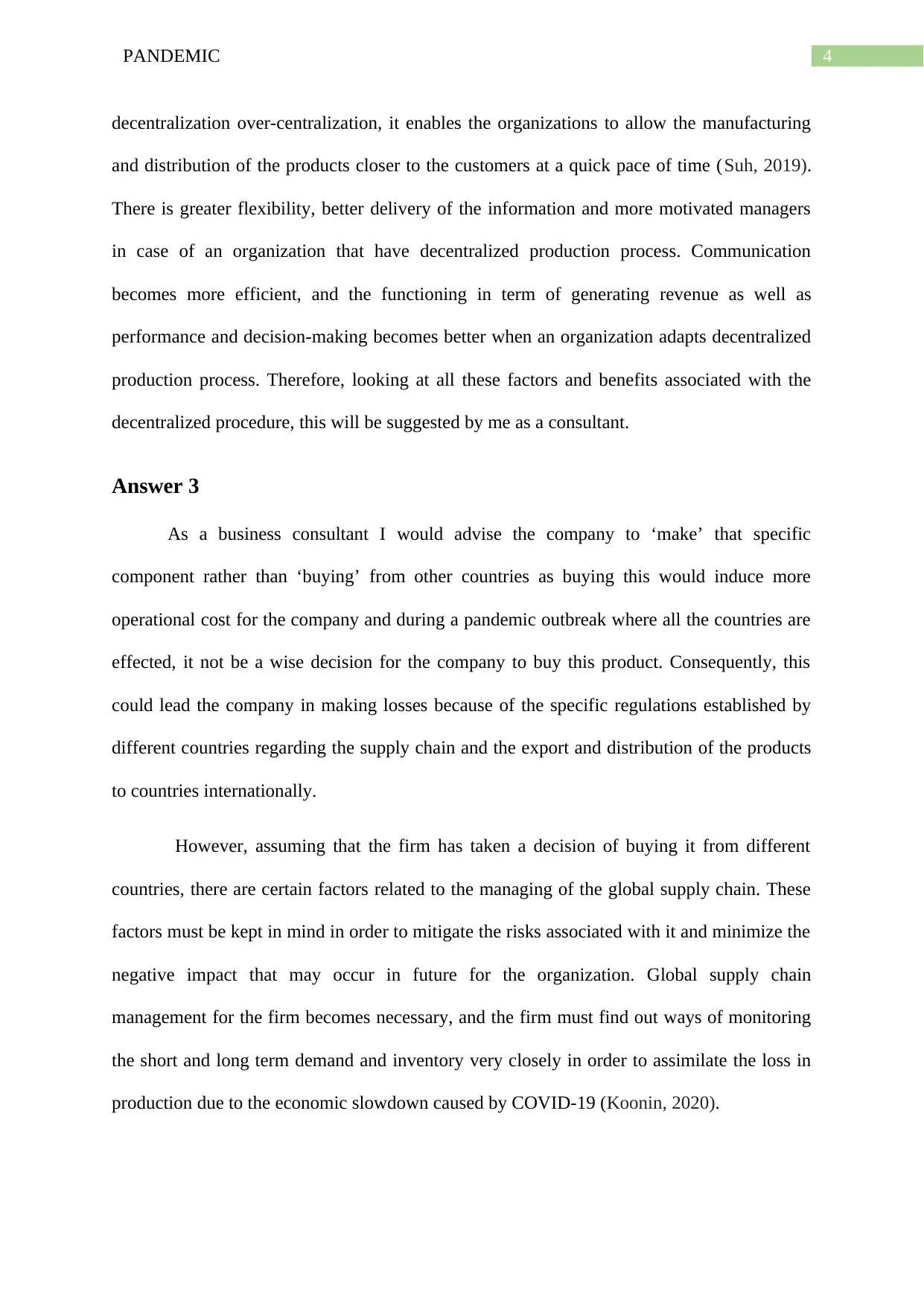
4PANDEMIC
decentralization over-centralization, it enables the organizations to allow the manufacturing
and distribution of the products closer to the customers at a quick pace of time (Suh, 2019).
There is greater flexibility, better delivery of the information and more motivated managers
in case of an organization that have decentralized production process. Communication
becomes more efficient, and the functioning in term of generating revenue as well as
performance and decision-making becomes better when an organization adapts decentralized
production process. Therefore, looking at all these factors and benefits associated with the
decentralized procedure, this will be suggested by me as a consultant.
Answer 3
As a business consultant I would advise the company to ‘make’ that specific
component rather than ‘buying’ from other countries as buying this would induce more
operational cost for the company and during a pandemic outbreak where all the countries are
effected, it not be a wise decision for the company to buy this product. Consequently, this
could lead the company in making losses because of the specific regulations established by
different countries regarding the supply chain and the export and distribution of the products
to countries internationally.
However, assuming that the firm has taken a decision of buying it from different
countries, there are certain factors related to the managing of the global supply chain. These
factors must be kept in mind in order to mitigate the risks associated with it and minimize the
negative impact that may occur in future for the organization. Global supply chain
management for the firm becomes necessary, and the firm must find out ways of monitoring
the short and long term demand and inventory very closely in order to assimilate the loss in
production due to the economic slowdown caused by COVID-19 (Koonin, 2020).
decentralization over-centralization, it enables the organizations to allow the manufacturing
and distribution of the products closer to the customers at a quick pace of time (Suh, 2019).
There is greater flexibility, better delivery of the information and more motivated managers
in case of an organization that have decentralized production process. Communication
becomes more efficient, and the functioning in term of generating revenue as well as
performance and decision-making becomes better when an organization adapts decentralized
production process. Therefore, looking at all these factors and benefits associated with the
decentralized procedure, this will be suggested by me as a consultant.
Answer 3
As a business consultant I would advise the company to ‘make’ that specific
component rather than ‘buying’ from other countries as buying this would induce more
operational cost for the company and during a pandemic outbreak where all the countries are
effected, it not be a wise decision for the company to buy this product. Consequently, this
could lead the company in making losses because of the specific regulations established by
different countries regarding the supply chain and the export and distribution of the products
to countries internationally.
However, assuming that the firm has taken a decision of buying it from different
countries, there are certain factors related to the managing of the global supply chain. These
factors must be kept in mind in order to mitigate the risks associated with it and minimize the
negative impact that may occur in future for the organization. Global supply chain
management for the firm becomes necessary, and the firm must find out ways of monitoring
the short and long term demand and inventory very closely in order to assimilate the loss in
production due to the economic slowdown caused by COVID-19 (Koonin, 2020).
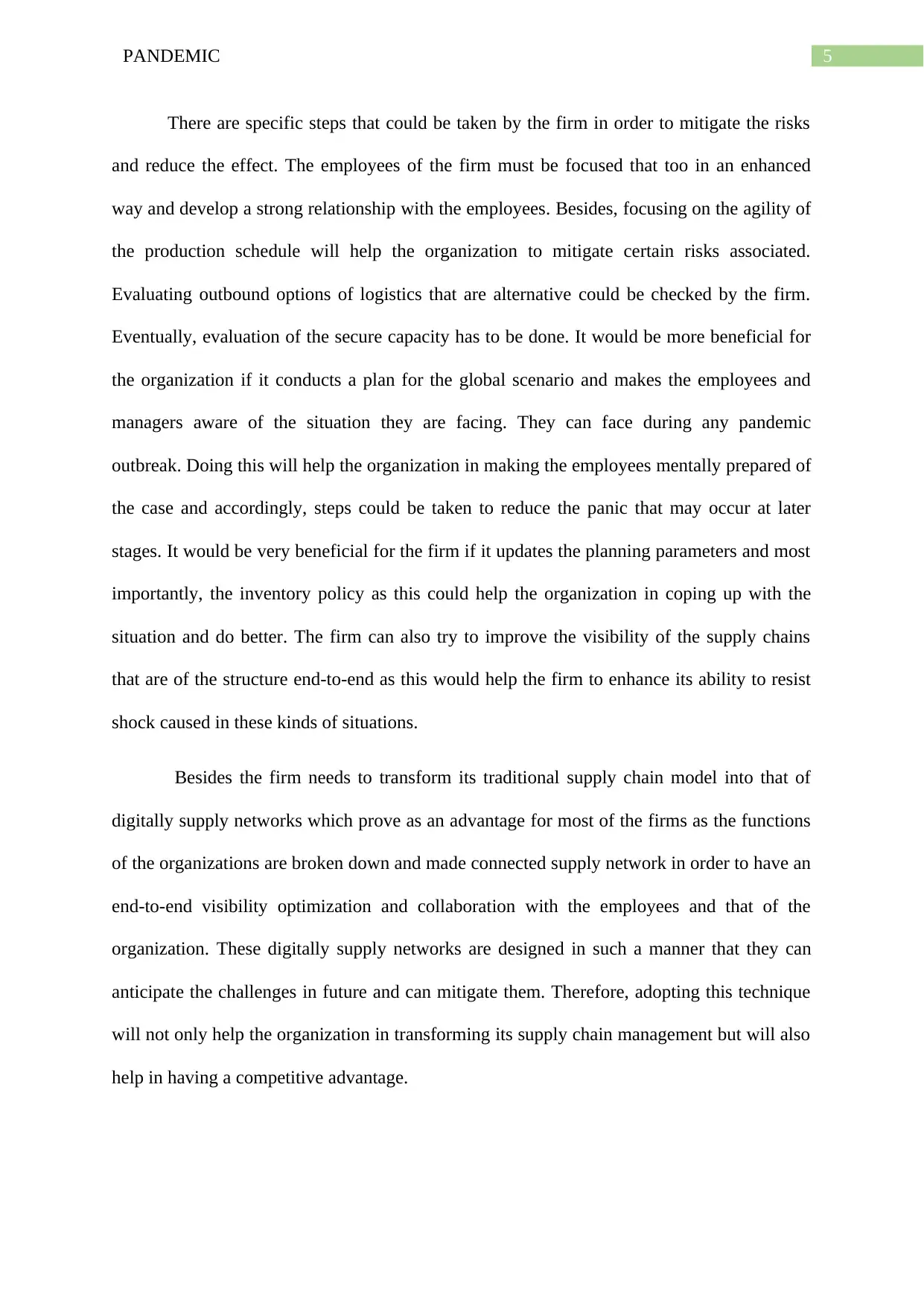
5PANDEMIC
There are specific steps that could be taken by the firm in order to mitigate the risks
and reduce the effect. The employees of the firm must be focused that too in an enhanced
way and develop a strong relationship with the employees. Besides, focusing on the agility of
the production schedule will help the organization to mitigate certain risks associated.
Evaluating outbound options of logistics that are alternative could be checked by the firm.
Eventually, evaluation of the secure capacity has to be done. It would be more beneficial for
the organization if it conducts a plan for the global scenario and makes the employees and
managers aware of the situation they are facing. They can face during any pandemic
outbreak. Doing this will help the organization in making the employees mentally prepared of
the case and accordingly, steps could be taken to reduce the panic that may occur at later
stages. It would be very beneficial for the firm if it updates the planning parameters and most
importantly, the inventory policy as this could help the organization in coping up with the
situation and do better. The firm can also try to improve the visibility of the supply chains
that are of the structure end-to-end as this would help the firm to enhance its ability to resist
shock caused in these kinds of situations.
Besides the firm needs to transform its traditional supply chain model into that of
digitally supply networks which prove as an advantage for most of the firms as the functions
of the organizations are broken down and made connected supply network in order to have an
end-to-end visibility optimization and collaboration with the employees and that of the
organization. These digitally supply networks are designed in such a manner that they can
anticipate the challenges in future and can mitigate them. Therefore, adopting this technique
will not only help the organization in transforming its supply chain management but will also
help in having a competitive advantage.
There are specific steps that could be taken by the firm in order to mitigate the risks
and reduce the effect. The employees of the firm must be focused that too in an enhanced
way and develop a strong relationship with the employees. Besides, focusing on the agility of
the production schedule will help the organization to mitigate certain risks associated.
Evaluating outbound options of logistics that are alternative could be checked by the firm.
Eventually, evaluation of the secure capacity has to be done. It would be more beneficial for
the organization if it conducts a plan for the global scenario and makes the employees and
managers aware of the situation they are facing. They can face during any pandemic
outbreak. Doing this will help the organization in making the employees mentally prepared of
the case and accordingly, steps could be taken to reduce the panic that may occur at later
stages. It would be very beneficial for the firm if it updates the planning parameters and most
importantly, the inventory policy as this could help the organization in coping up with the
situation and do better. The firm can also try to improve the visibility of the supply chains
that are of the structure end-to-end as this would help the firm to enhance its ability to resist
shock caused in these kinds of situations.
Besides the firm needs to transform its traditional supply chain model into that of
digitally supply networks which prove as an advantage for most of the firms as the functions
of the organizations are broken down and made connected supply network in order to have an
end-to-end visibility optimization and collaboration with the employees and that of the
organization. These digitally supply networks are designed in such a manner that they can
anticipate the challenges in future and can mitigate them. Therefore, adopting this technique
will not only help the organization in transforming its supply chain management but will also
help in having a competitive advantage.
⊘ This is a preview!⊘
Do you want full access?
Subscribe today to unlock all pages.

Trusted by 1+ million students worldwide
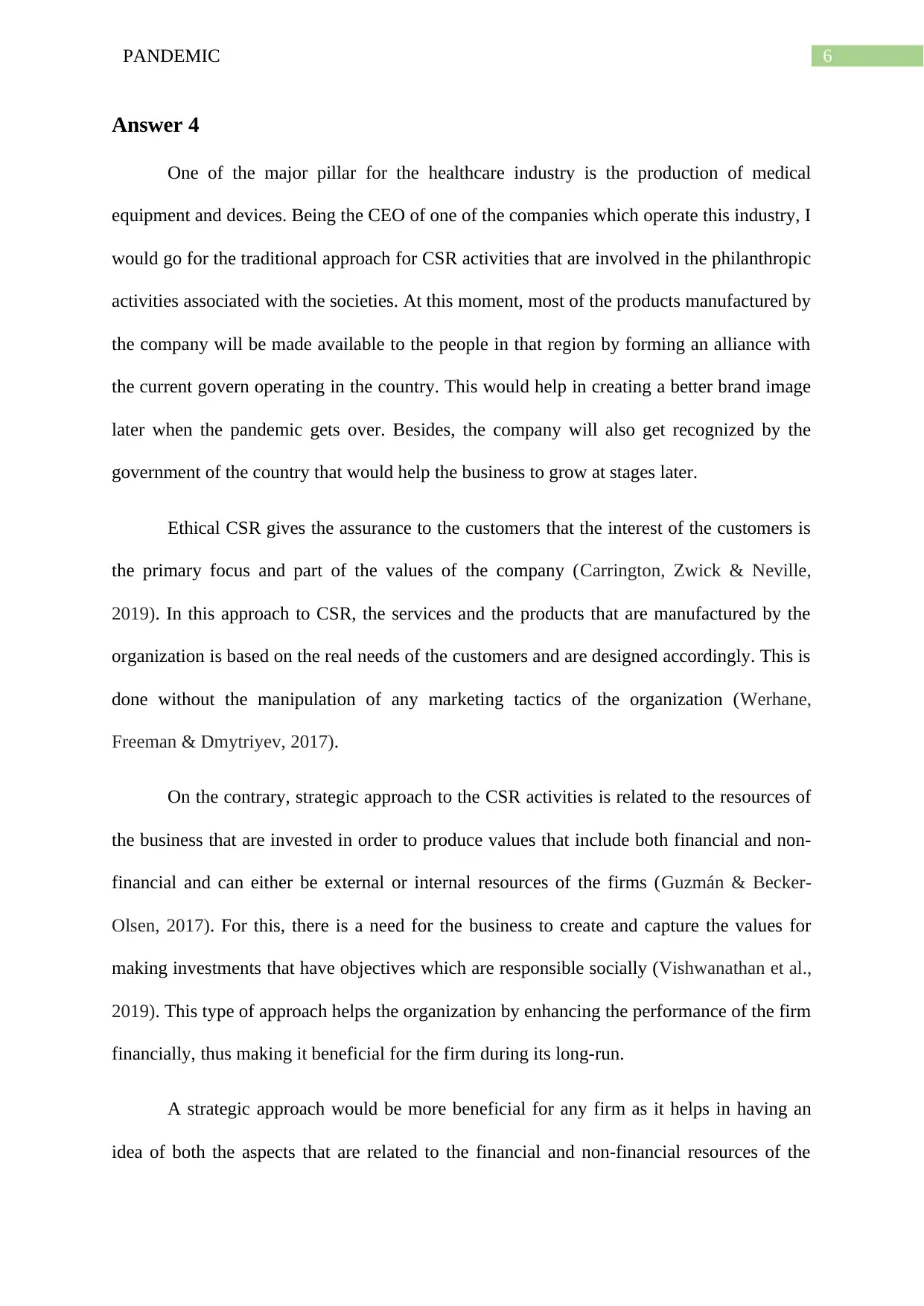
6PANDEMIC
Answer 4
One of the major pillar for the healthcare industry is the production of medical
equipment and devices. Being the CEO of one of the companies which operate this industry, I
would go for the traditional approach for CSR activities that are involved in the philanthropic
activities associated with the societies. At this moment, most of the products manufactured by
the company will be made available to the people in that region by forming an alliance with
the current govern operating in the country. This would help in creating a better brand image
later when the pandemic gets over. Besides, the company will also get recognized by the
government of the country that would help the business to grow at stages later.
Ethical CSR gives the assurance to the customers that the interest of the customers is
the primary focus and part of the values of the company (Carrington, Zwick & Neville,
2019). In this approach to CSR, the services and the products that are manufactured by the
organization is based on the real needs of the customers and are designed accordingly. This is
done without the manipulation of any marketing tactics of the organization (Werhane,
Freeman & Dmytriyev, 2017).
On the contrary, strategic approach to the CSR activities is related to the resources of
the business that are invested in order to produce values that include both financial and non-
financial and can either be external or internal resources of the firms (Guzmán & Becker-
Olsen, 2017). For this, there is a need for the business to create and capture the values for
making investments that have objectives which are responsible socially (Vishwanathan et al.,
2019). This type of approach helps the organization by enhancing the performance of the firm
financially, thus making it beneficial for the firm during its long-run.
A strategic approach would be more beneficial for any firm as it helps in having an
idea of both the aspects that are related to the financial and non-financial resources of the
Answer 4
One of the major pillar for the healthcare industry is the production of medical
equipment and devices. Being the CEO of one of the companies which operate this industry, I
would go for the traditional approach for CSR activities that are involved in the philanthropic
activities associated with the societies. At this moment, most of the products manufactured by
the company will be made available to the people in that region by forming an alliance with
the current govern operating in the country. This would help in creating a better brand image
later when the pandemic gets over. Besides, the company will also get recognized by the
government of the country that would help the business to grow at stages later.
Ethical CSR gives the assurance to the customers that the interest of the customers is
the primary focus and part of the values of the company (Carrington, Zwick & Neville,
2019). In this approach to CSR, the services and the products that are manufactured by the
organization is based on the real needs of the customers and are designed accordingly. This is
done without the manipulation of any marketing tactics of the organization (Werhane,
Freeman & Dmytriyev, 2017).
On the contrary, strategic approach to the CSR activities is related to the resources of
the business that are invested in order to produce values that include both financial and non-
financial and can either be external or internal resources of the firms (Guzmán & Becker-
Olsen, 2017). For this, there is a need for the business to create and capture the values for
making investments that have objectives which are responsible socially (Vishwanathan et al.,
2019). This type of approach helps the organization by enhancing the performance of the firm
financially, thus making it beneficial for the firm during its long-run.
A strategic approach would be more beneficial for any firm as it helps in having an
idea of both the aspects that are related to the financial and non-financial resources of the
Paraphrase This Document
Need a fresh take? Get an instant paraphrase of this document with our AI Paraphraser
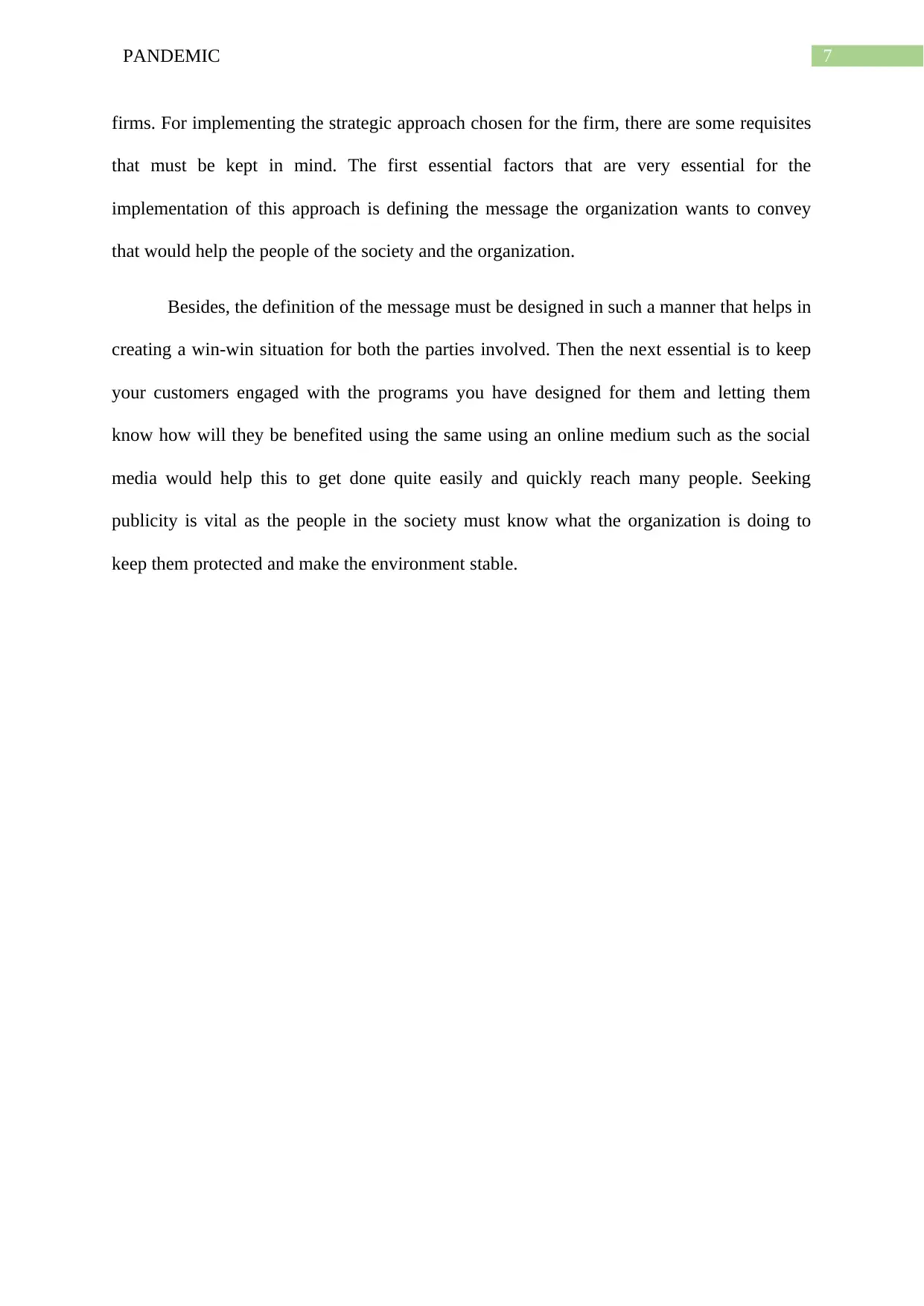
7PANDEMIC
firms. For implementing the strategic approach chosen for the firm, there are some requisites
that must be kept in mind. The first essential factors that are very essential for the
implementation of this approach is defining the message the organization wants to convey
that would help the people of the society and the organization.
Besides, the definition of the message must be designed in such a manner that helps in
creating a win-win situation for both the parties involved. Then the next essential is to keep
your customers engaged with the programs you have designed for them and letting them
know how will they be benefited using the same using an online medium such as the social
media would help this to get done quite easily and quickly reach many people. Seeking
publicity is vital as the people in the society must know what the organization is doing to
keep them protected and make the environment stable.
firms. For implementing the strategic approach chosen for the firm, there are some requisites
that must be kept in mind. The first essential factors that are very essential for the
implementation of this approach is defining the message the organization wants to convey
that would help the people of the society and the organization.
Besides, the definition of the message must be designed in such a manner that helps in
creating a win-win situation for both the parties involved. Then the next essential is to keep
your customers engaged with the programs you have designed for them and letting them
know how will they be benefited using the same using an online medium such as the social
media would help this to get done quite easily and quickly reach many people. Seeking
publicity is vital as the people in the society must know what the organization is doing to
keep them protected and make the environment stable.
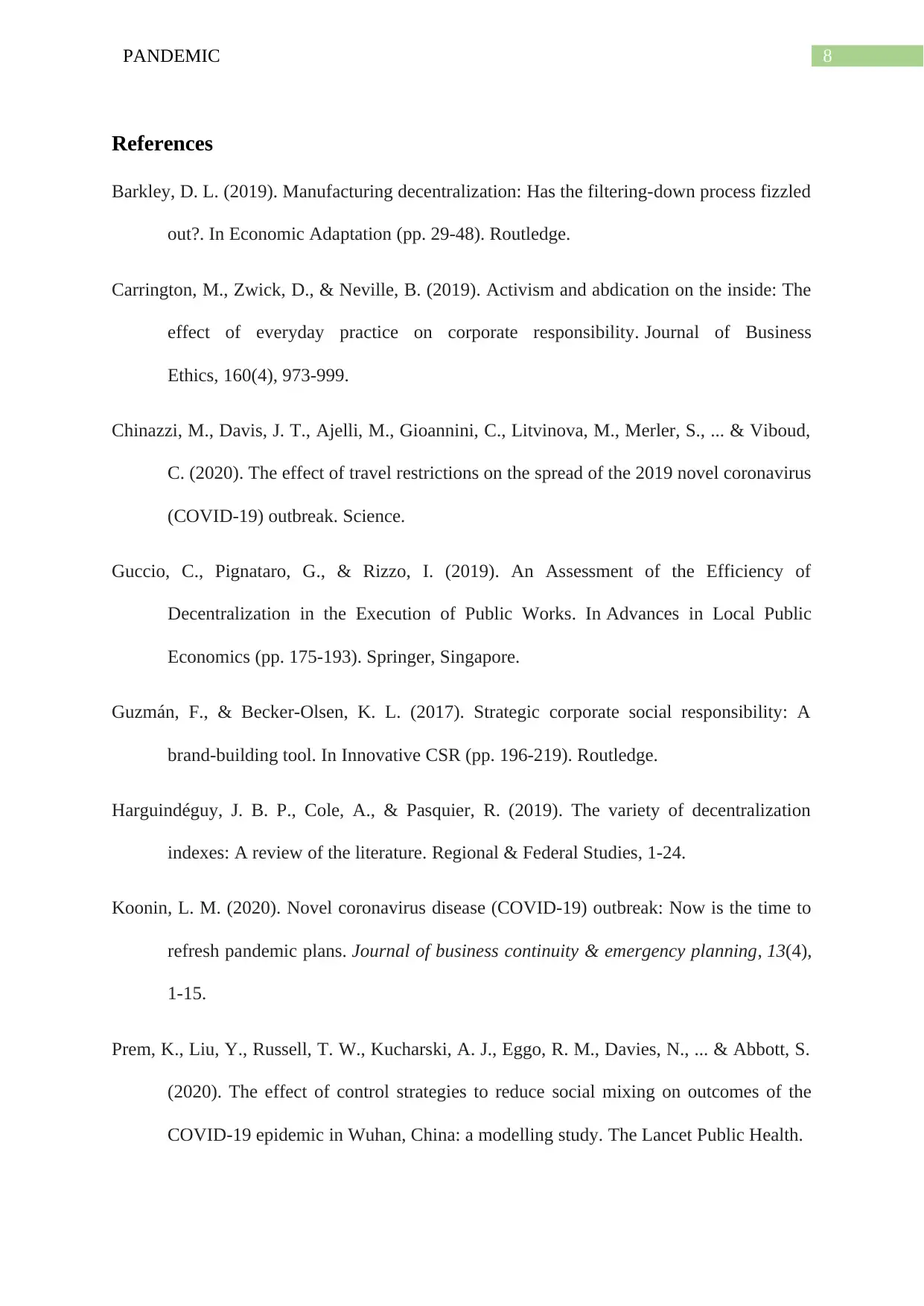
8PANDEMIC
References
Barkley, D. L. (2019). Manufacturing decentralization: Has the filtering-down process fizzled
out?. In Economic Adaptation (pp. 29-48). Routledge.
Carrington, M., Zwick, D., & Neville, B. (2019). Activism and abdication on the inside: The
effect of everyday practice on corporate responsibility. Journal of Business
Ethics, 160(4), 973-999.
Chinazzi, M., Davis, J. T., Ajelli, M., Gioannini, C., Litvinova, M., Merler, S., ... & Viboud,
C. (2020). The effect of travel restrictions on the spread of the 2019 novel coronavirus
(COVID-19) outbreak. Science.
Guccio, C., Pignataro, G., & Rizzo, I. (2019). An Assessment of the Efficiency of
Decentralization in the Execution of Public Works. In Advances in Local Public
Economics (pp. 175-193). Springer, Singapore.
Guzmán, F., & Becker-Olsen, K. L. (2017). Strategic corporate social responsibility: A
brand-building tool. In Innovative CSR (pp. 196-219). Routledge.
Harguindéguy, J. B. P., Cole, A., & Pasquier, R. (2019). The variety of decentralization
indexes: A review of the literature. Regional & Federal Studies, 1-24.
Koonin, L. M. (2020). Novel coronavirus disease (COVID-19) outbreak: Now is the time to
refresh pandemic plans. Journal of business continuity & emergency planning, 13(4),
1-15.
Prem, K., Liu, Y., Russell, T. W., Kucharski, A. J., Eggo, R. M., Davies, N., ... & Abbott, S.
(2020). The effect of control strategies to reduce social mixing on outcomes of the
COVID-19 epidemic in Wuhan, China: a modelling study. The Lancet Public Health.
References
Barkley, D. L. (2019). Manufacturing decentralization: Has the filtering-down process fizzled
out?. In Economic Adaptation (pp. 29-48). Routledge.
Carrington, M., Zwick, D., & Neville, B. (2019). Activism and abdication on the inside: The
effect of everyday practice on corporate responsibility. Journal of Business
Ethics, 160(4), 973-999.
Chinazzi, M., Davis, J. T., Ajelli, M., Gioannini, C., Litvinova, M., Merler, S., ... & Viboud,
C. (2020). The effect of travel restrictions on the spread of the 2019 novel coronavirus
(COVID-19) outbreak. Science.
Guccio, C., Pignataro, G., & Rizzo, I. (2019). An Assessment of the Efficiency of
Decentralization in the Execution of Public Works. In Advances in Local Public
Economics (pp. 175-193). Springer, Singapore.
Guzmán, F., & Becker-Olsen, K. L. (2017). Strategic corporate social responsibility: A
brand-building tool. In Innovative CSR (pp. 196-219). Routledge.
Harguindéguy, J. B. P., Cole, A., & Pasquier, R. (2019). The variety of decentralization
indexes: A review of the literature. Regional & Federal Studies, 1-24.
Koonin, L. M. (2020). Novel coronavirus disease (COVID-19) outbreak: Now is the time to
refresh pandemic plans. Journal of business continuity & emergency planning, 13(4),
1-15.
Prem, K., Liu, Y., Russell, T. W., Kucharski, A. J., Eggo, R. M., Davies, N., ... & Abbott, S.
(2020). The effect of control strategies to reduce social mixing on outcomes of the
COVID-19 epidemic in Wuhan, China: a modelling study. The Lancet Public Health.
⊘ This is a preview!⊘
Do you want full access?
Subscribe today to unlock all pages.

Trusted by 1+ million students worldwide
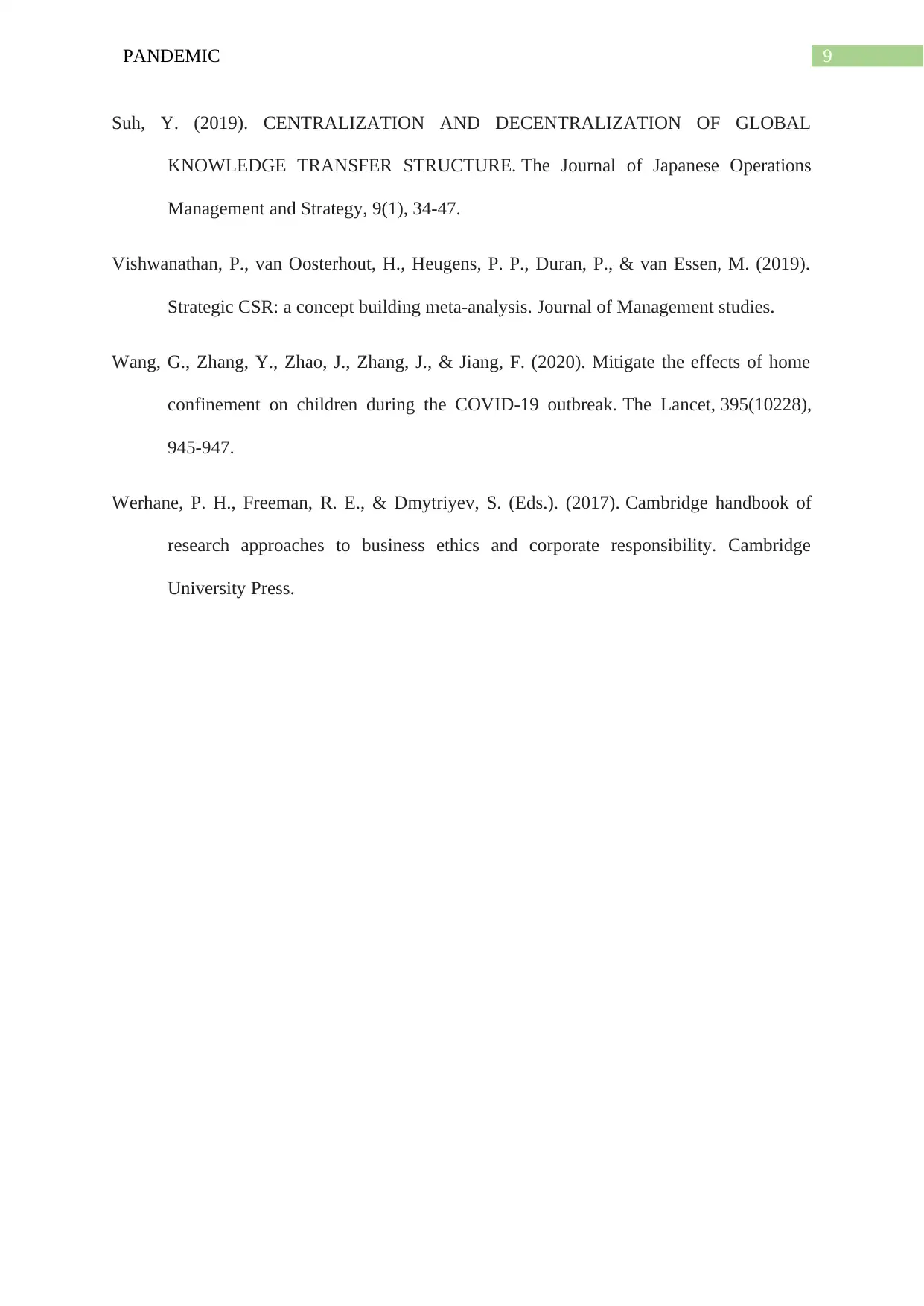
9PANDEMIC
Suh, Y. (2019). CENTRALIZATION AND DECENTRALIZATION OF GLOBAL
KNOWLEDGE TRANSFER STRUCTURE. The Journal of Japanese Operations
Management and Strategy, 9(1), 34-47.
Vishwanathan, P., van Oosterhout, H., Heugens, P. P., Duran, P., & van Essen, M. (2019).
Strategic CSR: a concept building meta‐analysis. Journal of Management studies.
Wang, G., Zhang, Y., Zhao, J., Zhang, J., & Jiang, F. (2020). Mitigate the effects of home
confinement on children during the COVID-19 outbreak. The Lancet, 395(10228),
945-947.
Werhane, P. H., Freeman, R. E., & Dmytriyev, S. (Eds.). (2017). Cambridge handbook of
research approaches to business ethics and corporate responsibility. Cambridge
University Press.
Suh, Y. (2019). CENTRALIZATION AND DECENTRALIZATION OF GLOBAL
KNOWLEDGE TRANSFER STRUCTURE. The Journal of Japanese Operations
Management and Strategy, 9(1), 34-47.
Vishwanathan, P., van Oosterhout, H., Heugens, P. P., Duran, P., & van Essen, M. (2019).
Strategic CSR: a concept building meta‐analysis. Journal of Management studies.
Wang, G., Zhang, Y., Zhao, J., Zhang, J., & Jiang, F. (2020). Mitigate the effects of home
confinement on children during the COVID-19 outbreak. The Lancet, 395(10228),
945-947.
Werhane, P. H., Freeman, R. E., & Dmytriyev, S. (Eds.). (2017). Cambridge handbook of
research approaches to business ethics and corporate responsibility. Cambridge
University Press.
1 out of 10
Related Documents
Your All-in-One AI-Powered Toolkit for Academic Success.
+13062052269
info@desklib.com
Available 24*7 on WhatsApp / Email
![[object Object]](/_next/static/media/star-bottom.7253800d.svg)
Unlock your academic potential
Copyright © 2020–2025 A2Z Services. All Rights Reserved. Developed and managed by ZUCOL.


